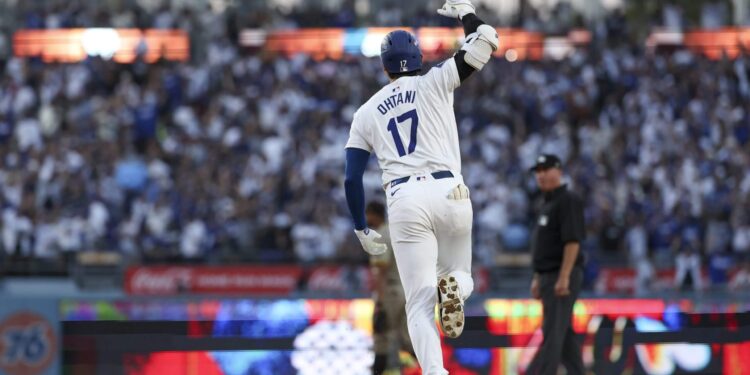LOS ANGELES — Shohei Ohtani bounded through the puddles of Budweiser and the plumes of cigar smoke polluting the Dodgers clubhouse. He wore a smile as he emerged, drenched but delighted, from the bacchanalia as the team celebrated its victory over the Padres in the National League Division Series. On his way out of the room, Ohtani passed the man who inked him to a $700 million contract last winter, specifically to stage parties like this.
“You know,” owner Mark Walter said to vice president of baseball development Raúl Ibañez, “that’s the first playoff series win for Shohei.”
Ohtani is never an afterthought, but Game 5 marked the rare occasion in which he was not a main character. Yoshinobu Yamamoto silenced San Diego for five innings. Kiké Hernández and Teoscar Hernández provided the biggest swings. Ohtani never reached base. It was a quiet ending to a postseason that opened for Ohtani with a bang.
The Dodgers may not have advanced to face the Mets in the National League Championship Series without Ohtani’s three-run shot against San Diego in Game 1. The homer revived the club after Yamamoto spotted San Diego an early lead. During the next four games, San Diego kept him from smashing balls over the fence and causing havoc on the bases. Ohtani went 2-for-15 with eight strikeouts after Game 1.

Shohei Ohtani struggled after Game 1, when he homered. (Kiyoshi Mio / Imagn Images)
Ohtani’s relative cold streak did not sink the club. Mookie Betts came alive with homers in Game 3 and Game 4. Teoscar Hernández posted a 1.067 OPS. Kiké Hernandez fortified his reputation as an October darling. The output was enough to put away San Diego.
“Twenty-six guys are gonna win it,” Betts said. “Not just Ohtani. Not just Mookie. Not just Yamamoto. It’s gonna take all of us. We showed that we have a well-rounded team.”
Yet their biggest star will always be Ohtani. The Dodgers survived a five-game brawl with San Diego but did not emerge unscathed. Freddie Freeman is still nursing a sprained ankle. Miguel Rojas is limited by a groin injury. The group could use Ohtani replicating his performance in the final two weeks of the season, when he hit .547 with seven home runs and 11 stolen bases.
Ohtani stole 59 bags in the regular season and none in the NLDS, in part because the Padres kept him off the bases. Manager Dave Roberts acknowledged that against San Diego Ohtani chased pitches “more outside the hitting zone than he (had) in the last, call it, six to eight weeks.” Roberts suggested that trend may not continue against the Mets, mostly because the Mets do not employ pitchers like Padres right-handed starter Yu Darvish and left-handed reliever Tanner Scott.
Darvish retired Ohtani six times in six plate appearances split between Game 2 and Game 5. The Padres neutralized Ohtani late in games with Scott. Ohtani faced Scott four times. He struck out each time. The pitchers presented a blueprint for facing Ohtani. The challenge for the Mets will be determining if any of their pitchers can follow it.
Darvish befuddled Ohtani. Scott overwhelmed him. For the Mets, only one path looks likely in this series.
Part of the issue involves personnel. The Mets carried only two left-handed relievers in the NLDS against Philadelphia. David Peterson is a converted starter who handles lengthier assignments; he is likely to follow Kodai Senga in Game 1. The other lefty, Danny Young, did not appear against the Phillies. His fastball sits around 91 mph — a far cry from Scott’s higher-octane arsenal.
Rival evaluators believe pitchers can disarm Ohtani by firing fastballs up and in. That is considered a hole Ohtani has not yet closed. Yet reaching that location can be perilous. Misses can leak over the plate, in the sort of spot where Ohtani can send them into orbit. Facing Ohtani, Scott did not miss. He pumped fastballs for strikes and eventually lured him out of the strike zone with high-90s heat.
The Mets do not employ a reliever capable of mirroring Scott. But their starters could take some cues from Darvish. Dodgers officials view the Mets starting rotation as a strength of their opponents, specifically the left-handed duo of Game 2 starter Sean Manaea and Jose Quintana, who will start either Game 3 or Game 4.
No pitcher can truly mimic Darvish, who throws so many variations of so many different pitches that his arsenal might stretch into double digits. But Manaea throws six pitches. Quintana throws five. They could try to mix and match to bait Ohtani, as Darvish did.
Roberts noted that Ohtani idolized Darvish in his youth. It was possible, the manager said, that added a layer of nerves to Ohtani’s at-bats. That dynamic will not exist against the Mets.
“So suffice to say,” Roberts said, “I’m happy that we’ve rid ourselves of Yu Darvish and we can sort of move forward.”
(Top photo of Shohei Ohtani striking out in the NLDS: Harry How / Getty Images)







